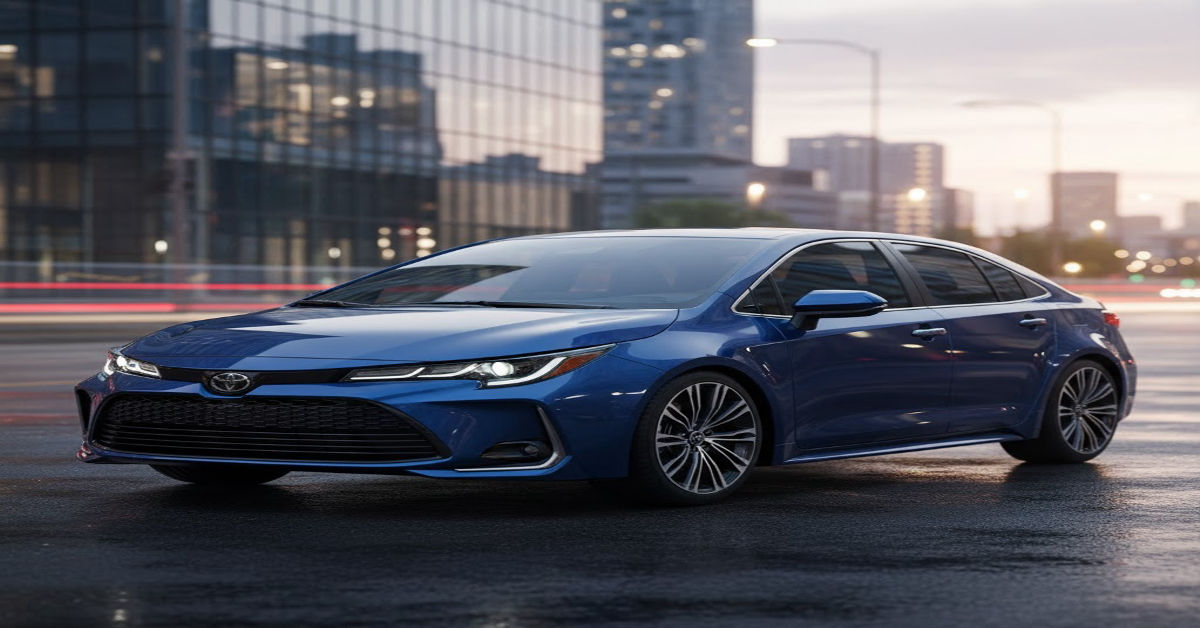Few vehicles have shaped global mobility as profoundly as the Toyota Corolla. Since its debut in 1966, it has become a universal symbol of reliability, reaching more than 50 million units sold worldwide. Today, the 2025 Toyota Corolla arrives at a moment of transition—not just for Toyota, but for drivers navigating a rapidly evolving automotive landscape shaped by electrification, software-driven interfaces and soaring consumer expectations.
Within the first 100 words, let’s answer the core question: What’s new in the 2025 Corolla? The model introduces an upgraded interior with more refined materials, new 8- and 10.5-inch touchscreen options, improved wireless connectivity, Toyota Safety Sense 3.0 as standard and modest but meaningful tuning to its chassis and ride quality. For hybrid variants, Toyota deploys its latest fifth-generation hybrid system, designed for smoother transitions and better energy recapture.
Depending on the market, the 2025 Corolla spans a wide range—Pakistan sees 1.6L and 1.8L petrol engines with 12–14 km/l real-world economy, while U.S. models rely primarily on a 2.0L inline-four delivering up to 35 mpg in combined EPA estimates. Hybrid drivers report everything from mid-30s to over 60 mpg depending on climate and driving habits—showing just how varied real-world conditions can be.
The 2025 Corolla is not a reinvention. Nor does it attempt to be. Instead, it sharpens the formula that made it a global phenomenon: balanced usability, predictable ownership costs, and a reputation for dependability that borders on mythical. It is a subtle evolution—measured, careful, and unmistakably Toyota.
Design and Engineering: Quiet Improvements That Matter
Toyota does not redesign the Corolla with sweeping drama. Instead, the 2025 model leans into refinement. Engineers adjusted the suspension to reduce harshness from potholes and rough pavement, while delivering firmer stability during highway speeds. This dual focus supports the Corolla’s role as an everyday workhorse.
The 2.0-liter engine available in U.S. models remains naturally aspirated, favoring reliability over turbocharged complexity. It pairs with a CVT that some drivers describe as smoother in city driving but less engaging at sustained high speeds. Hybrid variants, meanwhile, benefit from Toyota’s newest hybrid system, which improves regenerative braking and reduces the abrupt handoff between electric and combustion power.
These technical shifts won’t dazzle enthusiasts, but they serve the Corolla’s core mission: durability, predictability, and simplicity.
Interior and Infotainment: Finally, a Modern Cabin
Toyota’s interior philosophy for the 2025 Corolla emphasizes tactile comfort and digital clarity. SofTex-trimmed seats on higher trims combine soft, leather-like texture with durability. The cabin materials feel better tailored, particularly around touchpoints like the steering wheel, shifter, and center console.
The big change, however, is the technology. With standard 8-inch and optional 10.5-inch touchscreens, the Corolla’s infotainment no longer feels behind the curve. Wireless smartphone integration, Wi-Fi connectivity with limited trial data, and a 7-inch digital gauge cluster help position the Corolla closer to tech-forward competitors.
Even so, Toyota maintains its conservative approach: tech that feels functional, not showy.
Safety and Driver Assistance
Safety remains a non-negotiable priority, and the 2025 Corolla continues that tradition. Toyota Safety Sense 3.0 brings:
- Automatic emergency braking
- Forward collision warnings
- Adaptive cruise control
- Lane-keeping assist
- Cyclist and pedestrian detection
Equally important is structural integrity. Engineers have stiffened portions of the frame, enhancing crash performance and steering response.
One notable challenge surfaced in Spain, where a software bug caused an intermittent stiffening of the brake pedal. Toyota responded by reprogramming the ECU in affected vehicles—demonstrating how modern cars increasingly rely on software maintenance as much as mechanical reliability.
Fuel Efficiency: Real-World Drivers Tell a More Complicated Story
EPA ratings list up to 35 mpg combined for the gas model. Hybrid models theoretically outperform this by significant margins—but user experiences paint a more nuanced picture.
Some hybrid owners report averages in the high 30s, especially in mixed highway commuting. Others post astonishing numbers—57 to 65 mpg—particularly in mild weather and stop-and-go environments where hybrids shine. A handful have even achieved 70–80 mpg on select short trips.
Drivers note temperature sensitivity: extreme heat or cold can drop hybrid efficiency by 5–10 mpg. Highway speeds, too, tend to penalize hybrids.
The picture is clear: Toyota’s hybrids are extremely efficient, but real-world numbers depend heavily on climate and driving style.
Global Variants: One Name, Many Cars
Depending on where you live, the 2025 Corolla may look very different:
- Pakistan:
1.6L and 1.8L engines, either manual or CVT, with real-world economy between 12–16 km/l. A trusted family car that holds strong resale value. - United States:
A standard 2.0L engine with CVT and widespread availability of Safety Sense 3.0 and hybrid options. Fuel economy and tech are top priorities. - Hybrid Markets:
Fifth-generation hybrid tech offers some of the best efficiency in the segment, though performance numbers vary.
This regional tailoring is central to the Corolla’s global influence. The model remains an automotive chameleon: familiar, adaptable, and deeply embedded in everyday life.
Engine and Market Comparison
| Market | Engine Options | Transmission | Power Output | Real-World/Estimated Economy |
| U.S. | 2.0 L inline-4 | CVT | ~168 hp (est.) | ~35 mpg combined |
| Pakistan | 1.6 / 1.8 L petrol | Manual / CVT | 120–138 hp | 12–16 km/l |
| Hybrid | 1.8 L + motor | eCVT | ~121 hp | 37–60+ mpg |
Key Features by Trim
| Feature Area | Base Trim | Mid/Premium | FX/Special Variants |
| Infotainment | 8-inch screen | Optional 10.5-inch | 10.5-inch standard |
| Connectivity | Wireless CarPlay/Android Auto | Wi-Fi Connect, Remote Connect | Same as mid/premium |
| Safety | Toyota Safety Sense 3.0 | Enhanced rigidity | Same as mid/premium |
Ownership Realities: Insurance, Reliability and Cost
Few cars deliver the Corolla’s combination of low maintenance costs, accessible parts pricing, and long-term durability. For insurers, this consistency translates into favorable premiums. For families—especially in markets like South Asia—the Corolla represents not just transportation but financial prudence.
Behavioral economists frequently point out that predictable ownership costs strongly influence buying decisions in middle-income households. The Toyota Corolla 2025, by maintaining mechanical simplicity in its gas engines and improving efficiency in hybrids, reinforces that trust.
Criticisms and Challenges
Still, no car is perfect.
- Some drivers dislike the CVT’s behavior at highway speeds, describing it as “sluggish” or “unresponsive.”
- Hybrid economy varies widely in real-world conditions.
- Extreme temperatures reduce efficiency.
- The brake ECU software issue—although fixed—reminds us that modern vehicles depend on ongoing digital oversight.
Yet these criticisms rarely overshadow the Corolla’s strengths. Most owners express satisfaction rooted in reliability and predictability.
Key Takeaways
- The 2025 Corolla refines rather than reinvents, focusing on comfort, technology, and fuel efficiency.
- New infotainment options—8-inch and 10.5-inch screens—bring the cabin into modern territory.
- Fuel economy is strong but varies widely for hybrid drivers depending on climate and driving style.
- Toyota Safety Sense 3.0 is standard, enhancing collision readiness and driver assistance.
- The Corolla remains globally diverse, adapting trims, engines, and features to local needs.
- While not without flaws, the model maintains Toyota’s reputation for stability and long-term value.
Conclusion
The 2025 Toyota Corolla enters a competitive landscape dominated by tech-heavy sedans and increasingly affordable EVs. Yet Toyota remains faithful to the Corolla’s core identity a practical, trustworthy, economically sensible car for everyday drivers. By improving connectivity, refining ride quality, and offering hybrid variants that—under the right conditions—deliver remarkable fuel efficiency, Toyota Corolla 2025 preserves what matters most while nudging the Corolla toward a more digital future.
Is it flashy? No. Will it impress performance enthusiasts? Probably not. But for millions of households across continents, the Corolla is not a statement—it’s a solution. And with the 2025 model, that solution remains firmly aligned with the realities of modern life: grounded, dependable, and quietly thoughtful.
FAQs
1. Is the 2025 Toyota Corolla fuel-efficient?
Yes. Gas models achieve around 35 mpg combined, while hybrid models may reach anywhere from 37 to 60+ mpg depending on climate and driving style.
2. What engine options does the 2025 Corolla offer?
Depending on market 1.6L and 1.8L engines in Pakistan, a 2.0L engine in the U.S., and a 1.8L hybrid system in multiple regions.
3. Does it include advanced safety features?
Yes—Toyota Safety Sense 3.0 is standard, offering adaptive cruise, automatic emergency braking, lane-keeping assist, and more.
4. What’s new in the interior?
Improved materials, SofTex-trimmed seats on higher trims, 8- and 10.5-inch touchscreens, wireless smartphone integration, and optional Wi-Fi/Remote Connect services.
5. Are there known issues?
A brake ECU software issue surfaced in Spain but was corrected by Toyota. Some drivers also report CVT sluggishness and hybrid efficiency drops in extreme temperatures.







